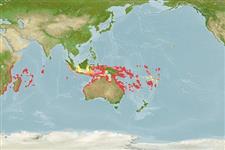Environment / Climate / Range
Ecology
Marine; reef-associated; depth range 5 - 30 m (Ref. 48635). Tropical, preferred ?; 0°S - 29°S, 32°E - 170°W
Indo-West Pacific: three known specimens from Natal, South Africa (Ref. 4315); also from north and northwestern Australia, and possibly extending to western Papua New Guinea. Reported from Samoa (Ref. 592).
Size / Weight / Age
Maturity: Lm ? range ? - ? cm
Max length : 10.0 cm TL male/unsexed; (Ref. 2334)
Short description
Morphology | Morphometrics
Dorsal
spines
(total): 9;
Dorsal
soft rays
(total): 11-111;
Anal
spines: 0;
Anal
soft rays: 11. Pale tan in color, whitish below; back crossed by a broad dark band at spiny dorsal and 2-3 smaller dark bands posteriorly; prominent black blotch on pelvic fins (Ref. 4315).
Inhabits coastal mud or sand channels and slopes (Ref. 48635). Feeds mainly on crabs, prawns, and also fish. Generally not used food (Ref. 2334).
Life cycle and mating behavior
Maturity | Reproduction | Spawning | Eggs | Fecundity | Larvae
Kailola, P.J., 1987. The fishes of Papua New Guinea: a revised and annotated checklist. Vol. II Scorpaenidae to Callionymidae. Research Bulletin No. 41, Research Section, Dept. of Fisheries and Marine Resources, Papua New Guinea. (Ref. 6192)
IUCN Red List Status (Ref. 115185)
CITES (Ref. 94142)
Not Evaluated
Threat to humans
Harmless
Human uses
More information
Common namesSynonymsMetabolismPredatorsEcotoxicologyReproductionMaturitySpawningFecundityEggsEgg development
Age/SizeGrowthLength-weightLength-lengthLength-frequenciesMorphometricsMorphologyLarvaeLarval dynamicsRecruitmentAbundance
ReferencesAquacultureAquaculture profileStrainsGeneticsAllele frequenciesHeritabilityDiseasesProcessingMass conversion
Tools
Special reports
Download XML
Internet sources
